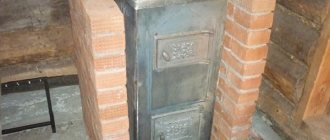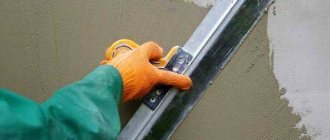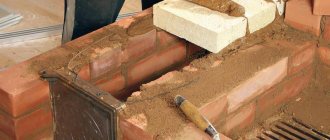A cinder block is a building product that is manufactured industrially or by handicraft. The production uses the method of vibration pressing of concrete in special forms.
Cinder block is one of the most popular building materials due to its low cost composition and low manufacturing cost.
What makes the product popular is the abundance of materials in the working solution—what the cinder block is made of.
How to make a mortar for laying cinder blocks: methods for mixing it
Category
: Solutions and mixtures
Published
: 2014-11-04
Author
: Administrator
Views
: 72018
How to make a mortar composition for laying cinder blocks worries all novice builders who have decided to lay out their own house. There are several types of such composition.
Types of masonry compositions
You can use several solution options:
- Prepared with your own hands.
- Purchased dry powder, for the production of which you will need a certain amount of water.
The price of ready-made mixtures can be several times more expensive than a self-prepared solution.
What properties should a mortar for laying cinder blocks have?
The proportions of the solution are different, it all depends on different cases. For this reason, the following plays an important role:
- Viscosity of the composition.
- Durability after drying.
- Spreadability when applied to the surface.
Also worth considering:
- The composition of the solution must be free of lumps.
- This will make it possible to lay the material evenly.
- Special additives are very popular in the preparation of the solution.
- They allow you to increase the strength and reliability of the composition.
The type of material laid determines not only the consumption of the product, but also its ingredients.
Types of cinder block masonry and material characteristics
The material is very popular and there are reasons for this:
- This is due to the large size of the material.
- They are 390x188x190 mm.
- The material has excellent characteristics and properties.
- Sound and heat insulation properties are high.
- The strength of a material is determined by its structure.
- Thanks to all the available ingredients, you can make a cinder block yourself.
- Only for such a process there are special instructions.
The amount of raw materials should be checked with professionals in this field.
The consumption of mortar per cubic meter of cinder block masonry depends on the type of masonry. The most economical is masonry of 0.5-1 blocks. The thickness of the mortar is 1-2 cm. It is not recommended to make it thicker, since then the building will not have high strength.
- Initially, the amount of material required for masonry is calculated.
- Then, based on the data obtained, the solution consumption for laying the cinder block is obtained.
- It also depends on the thickness of the applied product.
- To make the solution more economical, it is not recommended to apply it more than 10 mm.
Homemade solutions for laying cinder blocks
There are standard batches of mortar for laying cinder blocks, which are most often used in construction.
- They are characterized by the preparation of ordinary concrete mortar.
- It consists of concrete, sand and water.
- The sand-cement mixture is made up of 3-4 buckets of sand per 1 bucket of cement.
How to make mortar for laying cinder blocks? Below is an example of another fairly simple and standard mortar for laying material:
- Sand (purified or not, river or quarry).
- Portland cement (grade not lower than M 400 or M 500).
- Water.
- Red clay.
- Plasticizers that regulate the density of the solution.
- The ratio of sand and cement is 3 to 1.
- The container for determining the proportions of sand and cement must be the same. For example, a bucket or basin.
- It is also worth considering the size of the concrete mixer in which the mixture is mixed.
- It will be impossible to add or remove already mixed ingredients.
- Mortar for laying cinder blocks, proportions of this type imply the use of 3 buckets of sand and 1 bucket of cement and 1/3 bucket of red clay.
- Sand, cement and clay are poured into the prepared container.
- All of them are mixed using a special wooden shovel or a simple stick.
- After the concrete mixer begins to rotate, water is gradually added using a bucket of the same volume.
- Its quantity depends on what type of masonry is chosen.
- The total weight of the future structure is also taken into account. The solution must withstand all loads and securely secure the material.
You need to pour water into the dry mixture in buckets. Do not pour several buckets at once. This may result in a liquid solution that cannot be used for masonry. It will spread.
Solutions for laying cinder block:
What mixtures are used for installation?
The solution is necessary for reliable fastening of building elements to each other. It comes in two types :
- Dry purchased mixture . It is ready to use. The only thing you need to do is add the amount of water indicated in the instructions. The advantage of this composition is that it is easy and convenient to use. Plasticizers have already been added to it, giving it strength. However, it will cost more than homemade compounds. Considering the scale of construction, the amount can be impressive.
- Homemade solution . It is based on several components, the cost of which is low, so the use of such a composition allows you to significantly save your budget. The main disadvantage is the need for strict adherence to proportions. Their violation will negatively affect the properties of the mixture.
Advice! The thickness of the solution layer should be the same for both homemade and ready-made purchased compositions. Its increase does not contribute to increasing the strength of the structure.
Characteristics of cinder block
Cinder block has become very popular recently. This is due to the fact that its price is quite low. In terms of cost, such material is first in the ranking, as it is the cheapest. Types of cinder block:
- Full-bodied.
- Hollow.
- Standard material dimensions: 190x188x390 cm.
- There is hollowness in relation to the entire mass of the cinder block of 30% and 40%.
Advice. Solid cinder blocks are best used for constructing the foundation of a house (basement), as they can withstand fairly heavy loads. Hollow cinder block is used for the construction of non-multi-story buildings.
The most important component for making cinder blocks is slag. Also added:
- Wood sawdust or pine needles.
- Brick chips or scrap.
- Crushed stone or gravel.
- Sand.
- Expanded clay and water.
Thanks to this composition, the cost of cinder block is very low. Not everyone knows that you can prepare with your own hands not only the mortar for laying this material, but also the material itself.
Advice. If both the cinder block and the mortar for laying it are made independently, then there is an opportunity to save a lot on building a house.
The following are built from cinder block:
- Garage and other utility rooms.
- One- and two-story houses.
- Ground floors of the building.
The material is very light and does not require too deep a foundation.
Flaws
- Increased thermal conductivity: therefore, when constructing residential premises, it is recommended to insulate walls with a layer of expanded clay concrete blocks, which are not as durable, but much more capable of retaining heat. However, this disadvantage loses its effect if it is necessary to build unheated buildings (garden houses, garages, warehouses, sheds, etc.), fences, extensions, columnar foundations. Thermal conductivity is also not of decisive importance for internal partitions, where strength and sound insulation properties are primary.
- Low vapor permeability: walls made of sand concrete cannot be called “breathable”.
Areas of application of sand concrete blocks
Sand concrete blocks are universal in their application, and therefore they are used to construct residential and public buildings, industrial and auxiliary buildings of industrial and agricultural enterprises; create natural ventilation systems.
Cottages, outbuildings, garages, fences are examples of low-rise housing construction and related equipment using sand concrete blocks. With a wall thickness of 200 mm, it is possible to build high-rise buildings up to 10 floors.
Properties and technical characteristics of cinder block
Material Specifications
Builders who use cinder block in their work are attracted not only by its cost, but also by the good technical characteristics of the material. Cinder block:
- Moisture-resistant and does not burn even from direct exposure to a fire source.
- Not exposed to sunlight.
- Calmly tolerates temperature changes.
- Withstands both very high and very low temperatures.
- Its service life is at least 30 years.
- Due to the fact that the cinder block is quite large in size, less material can be used in the construction of a building compared to brick.
- It is able to withstand very heavy loads. This applies to a greater extent to solid cinder blocks.
Cinder block can be decorated with any modern finishing material. There are no restrictions here. This is due to the fact that its surface is smooth and is subject to any processing method.
Weight and popular sizes of sand concrete blocks
The weight of blocks with the same volume can be different, which is explained by the presence or absence of voids. So, a 400x200x200 block can weigh 22, 24 or 30 kg. In general, the approximate ranges are as follows: wall blocks weigh from 8 to 40 kg, foundation blocks - from 100 to 2000 kg.
Dimensions of wall blocks, mm:
- length - from 190 to 500
- width - from 90 to 500
- height - from 185 to 300
Dimensions of foundation blocks, mm:
- length - 880, 1180, 2380
- width - 300, 400, 500, 600
- height - 280, 580
Making your own cinder block
Instructions for making the material
In order to make a cinder block yourself, there are certain instructions according to which all actions are performed. This will save money on the purchase of finished building materials, since only raw materials are purchased and then only in rare cases. The solution for making cinder blocks consists of:
- Cement and sand.
- Water and slag.
- Brick chips and wood shavings are added.
This is the most primitive composition of the solution, which anyone can make if desired:
Advice. To increase the strength of the cinder block, various means are added during the mixing of the solution: hardeners. You can also speed up the drying time of the cinder block and additives are also added for this.
- It is not simple cement that is used in the solution, but Portland cement grade 400. As a rule, the ratio of sand and cement is 3 to 1. Depending on the container in which the solution is made, 5 parts of slag are added. Water is half of the cement used.
Advice. The most durable and reliable is cinder block, which is made without the use of sand. In this case, the proportion of slag in the solution increases and 1 bucket of cement accounts for 9 parts of slag.
You will also need special equipment:
- Hollow molds for pouring solid cinder blocks or with special attachments for hollow ones.
- A vibrating table that allows you to evenly distribute the solution in the mold and compact it in it.
- High temperature dryer.
What you need to know:
- At home, the latter device can hardly be found and for this reason all forms are exposed to the sunny side, where they undergo a stage of natural drying.
- This process is quite lengthy, but thanks to this the material does not lose its properties and characteristics.
Advice. To ensure that the solution for making cinder blocks is of high quality and has a uniform structure, a concrete mixer is used to mix it.
What other mixtures can be used?
To prepare the solution, you can use different types of mixtures, including :
- Composition for masonry M25. It is based on M300 cement with the addition of one part of sand.
- The M75 solution is based on the M400 solution with the addition of lime (0.5 parts) and sand (4 parts).
- Mixture M100. It is based on M400 cement, 0/3 parts lime and 4 parts sand.
- Mortar M150 based on cement with 2.5 parts sand and 0.1 parts lime.
Adhesive for cinder blocks
Adhesive for cinder blocks is often used instead of classic masonry mortars. It has a number of advantages :
- Increases the strength and durability of an object.
- Economically consumed per 1m3.
- Allows you to achieve good adhesion of blocks, which is possible due to the presence of fractional sand in the composition.
Glue is more expensive than conventional solutions, so it is advisable to use it in cases where the surface of the blocks is not porous and has ideal smoothness.
Another option is to carry out work in winter. The use of glue allows for better hardening of the seams.
Popular brands of adhesive for cinder block:
- Bergauf Kleben Block. Frost-resistant adhesive for cellular blocks.
- Normada.
- Ceresit ST 21. Adhesive for laying cellular concrete blocks.
Types of cinder block masonry
The consumption of mortar for laying cinder blocks depends on the type of masonry itself. And it could be:
- 0.5 cinder block (both hollow and solid material is used).
- In 1 cinder block (bonded).
- 1.5 cinder blocks (mostly solid material is used).
- 2 cinder blocks (both hollow and solid cinder blocks are used).
- The consumption of mortar per 1m3 of cinder block masonry will be greater than when laying the material in 0.5 cinder block.
Advice. It is worth considering that the masonry mortar is applied in a fairly large layer, the thickness of which is at least 1-1.6 cm.
In order to make high-quality cinder block laying you will need the following tool:
- A hydraulic level, with the help of which each element is set, and the masonry turns out smooth.
- Saw or hacksaw, since cinder block can be cut quite well.
- A simple building level.
- Mallet.
- Hammer.
- Fishing line or cord (plumb line). It helps make the masonry even.
- Order.
Advice. Precautionary measures when sawing cinder blocks include the use of a respirator to prevent dust from entering the respiratory tract.
The video shows the process of laying cinder blocks. Before making a solution for laying cinder blocks, you should initially select the type of laying material, since the consumption of the product will depend on it.
Transportation
Since sand concrete blocks of the same size can have different weights, the number of loaded units also varies. So, in a car with a carrying capacity of 20 tons, from 700 to 900 blocks with a volume of 400 × 200 × 200 mm are placed.
The shipment and transportation of the product should begin only after the concrete strength has reached the required value (tempering strength).
At the warehouse site or directly on the production line, the blocks are placed in flat or rack pallets, wrapped in film (shrink or stretch) and tied with steel or polymer tape. The height of the transport package formed in this way should not exceed 1.3 m.
When storing, ready-made transport packages are placed on the loading platform in stacks (in one or two tiers), maintaining a distance between them of at least 0.5 m. Blocks that have blind voids are placed in the package with the voids facing down.
Properties and functions of mortar for laying cinder block
What function does the solution play?
The main function for laying cinder block is to securely fasten the material. The solution itself must have a certain structure. It should not be too liquid or too thick. As a rule, the consistency of the product should resemble the structure of plaster.
Advice. To check the quality of the mortar for laying cinder blocks, you need to apply it to the surface using a trowel and see if it spreads too much. If this is observed, then you need to add more cement and sand to it in a ratio of 2 to 1.
The solution should be:
- Viscous.
- After hardening, it is durable.
- Fits freely on the surface of the material.
You can add hardeners or binding agents to it during the preparation process. But to prepare, you need to know the proportions of the mortar for laying cinder blocks and its composition.
Necessary components for preparation
The classic mortar for laying cinder blocks consists of three components:
Sand .
It must be clean, without foreign impurities that will lead to the formation of lumps. Sand must be purchased at the store. You can make a choice in favor of class II river or quarry sand, or a mixture of both. The grains of sand in it are small, so the adhesion to the surface will be strong.- Cement . The choice should be made in favor of Portland cement, which is a hydraulic binder based on gypsum, cement clinker and additives. Its brand must be no lower than M400 or M500.
- Water . It must be clean, without silt or mold, which can impair the quality of the adhesion of the solution and provoke the destruction of the structure. There should be no excess or deficiency of minerals in the water.











